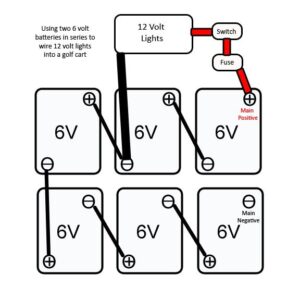How tight should battery terminals be? It’s a common question many car owners find themselves asking. Well, the answer is not as straightforward as you might think. While you don’t want them too loose, tightening them too much can also cause problems. Striking the right balance is essential for the optimum performance and longevity of your battery. In this article, we’ll explore the factors to consider and provide you with practical tips on achieving the perfect tightness for your battery terminals. So, whether you’re a novice car enthusiast or a seasoned driver, keep reading to ensure your battery terminals are in tip-top shape.
How Tight Should Battery Terminals Be?
When it comes to maintaining the performance of your vehicle’s battery, one essential aspect is ensuring that the battery terminals are properly tightened. The battery terminals play a crucial role in providing a secure connection between the battery and the electrical system of your vehicle. In this article, we will explore the importance of tight battery terminals and provide guidelines on how tight they should be.
The Role of Battery Terminals
Battery terminals, also referred to as battery posts, serve as the interface between the battery and the electrical system of your vehicle. They connect the battery’s power to various components, such as the starter, lights, and other electrical accessories. The terminals are typically made of lead or lead alloy and are attached to the battery cells.
Why Should Battery Terminals Be Tight?
Properly tightened battery terminals are essential for several reasons:
- Secure Connection: Tight battery terminals ensure a secure and uninterrupted electrical connection between the battery and the vehicle’s electrical system. Loose terminals can lead to voltage drops, which can affect the performance of electrical components.
- Preventing Corrosion: Loose terminals can lead to corrosion buildup at the connection points. Corrosion can impede the flow of electricity and weaken the connection, potentially resulting in starting issues or electrical failures.
- Heat Dissipation: Tight terminals help in efficient heat dissipation. During charging and discharging, batteries generate heat, and properly tightened terminals allow for better heat transfer from the battery.
How Tight Should Battery Terminals Be?
While it is crucial to tighten battery terminals, it is equally important not to overtighten them. Over-tightening can lead to damage to the battery and its terminals. The ideal tightness can vary depending on the type of battery, terminal design, and manufacturer recommendations. Here are some guidelines to help you ensure the right tightness:
1. Check the Manufacturer’s Recommendations
Different battery manufacturers may provide specific instructions regarding terminal tightness. It is recommended to consult the battery manufacturer’s manual or website for precise instructions on how tight the terminals should be. Following the manufacturer’s recommendations is crucial for preventing any potential damage to the battery or terminals.
2. Use a Torque Wrench
To achieve consistent and accurate tightness, consider using a torque wrench. A torque wrench allows you to tighten the terminals to a specific torque value. This helps prevent overtightening and ensures that all battery terminals are tightened evenly. Look for the recommended torque value in the battery manufacturer’s instructions.
3. Hand-Tighten First
Before using a torque wrench, it is essential to hand-tighten the terminals. Start by ensuring the terminals are correctly aligned with the battery posts. Then, carefully tighten them using your hand or a wrench until they are snug. Hand-tightening before using a torque wrench helps ensure proper positioning and avoids any cross-threading issues.
4. Follow a Cross-Pattern Tightening Sequence
When using a torque wrench to tighten the battery terminals, it is advisable to follow a cross-pattern sequence. This method ensures that the terminals are tightened evenly and helps maintain a consistent connection. Begin by tightening one terminal to a specific torque value, then move diagonally to the opposite terminal and repeat the process. Continue this pattern until all terminals are properly tightened.
5. Regularly Inspect and Retighten
Battery terminals can loosen over time due to various factors, including vibrations and temperature changes. It is good practice to regularly inspect the terminals and retighten them if necessary. Check for any signs of corrosion or loose connections during routine maintenance to ensure optimum performance.
Signs of Improperly Tightened Battery Terminals
While it is important to tighten battery terminals adequately, it is also crucial to recognize the signs of improperly tightened terminals. Here are some indications that your battery terminals may need adjustment:
- Difficulties in Starting the Vehicle: Loose terminals can lead to voltage drops, resulting in starting issues.
- Dim Lights or Electrical Failures: Inadequately tightened terminals may cause inconsistent electrical flow, leading to dim lights or failures in electrical accessories.
- Corrosion Buildup: If you notice corrosion around the battery terminals, it could indicate loose connections or acid leakage caused by inadequate terminal tightness.
In conclusion, ensuring the right tightness of battery terminals is crucial for maintaining the performance and longevity of your vehicle’s electrical system. Follow the manufacturer’s recommendations, use a torque wrench, and regularly inspect and retighten the terminals to prevent voltage drops, corrosion, and other related issues. By paying attention to this often overlooked aspect of battery maintenance, you can avoid potential electrical problems and enjoy a smooth and reliable driving experience.
Frequently Asked Questions
How tight should battery terminals be?
Ensuring the proper tightening of your battery terminals is crucial for optimal performance and safety. Here are some frequently asked questions related to this topic:
1. How do I know if my battery terminals are too loose?
If your battery terminals are too loose, you may experience various issues such as difficulty starting the engine, dimming lights, or intermittent power loss. It’s important to regularly check the tightness of your battery terminals to avoid these problems.
2. What is the recommended torque for battery terminal connections?
While specific torque values may vary depending on the battery and terminal type, a general guideline is to tighten the battery terminal connections to around 70-120 inch-pounds or 8-14 Newton-meters. However, it is always advisable to refer to your vehicle’s manual or consult a professional for the accurate torque specifications.
3. Can overtightening battery terminals cause any issues?
Yes, overtightening battery terminals can lead to problems. Excessive force may damage the terminal posts, battery case, or even strip the threads, making it difficult to remove or replace the terminals in the future. It’s essential to strike the right balance between tightness and avoiding excessive force.
4. How tight should I make the battery terminal clamps?
The battery terminal clamps should be tightened securely enough to ensure proper electrical contact and stability. Use a wrench or socket to tighten them snugly, but be careful not to overtighten and risk damaging the terminals or battery.
5. Should I apply any lubricant or anti-corrosion product to the battery terminals?
Applying a thin coat of petroleum jelly or specialized anti-corrosion spray on the battery terminals can help prevent corrosion and improve electrical conductivity. However, make sure to avoid getting any lubricant or spray on the battery posts as it may interfere with the connection.
6. How often should I check the tightness of my battery terminals?
It’s recommended to check the tightness of your battery terminals at least once every three to six months. Additionally, if you notice any signs of electrical issues or loose connections, it’s wise to inspect and tighten the terminals promptly.
Final Thoughts
Battery terminals should be tightened securely, but not overly tightened. The ideal tightness ensures a proper electrical connection without risking damage to the battery or terminals. Tightening the terminals too much can lead to cracks in the battery casing or terminals, which can result in poor electrical conductivity and potential safety hazards. On the other hand, loose terminals can cause intermittent contact, leading to issues like starting problems or electrical component failures. Therefore, it is recommended to tighten battery terminals to a level where they are snugly secured, ensuring a strong and reliable connection. So, how tight should battery terminals be? The answer lies in finding the balance between secure connection and avoiding excessive force.


